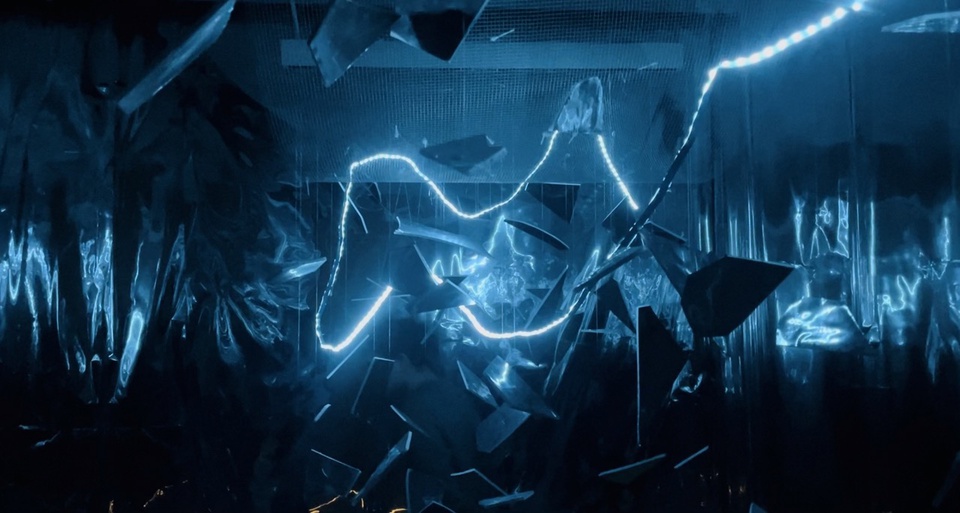{shortcode-bbbf42523e07520a7058917aeee0b0f38548c062}
Alina Yu ’25 is showing me a hilarious and terrifying video in the middle of a Harvard undergraduate dining hall in Mather House. In the video, her friend is participating in a virtual reality experience that she helped build; we can see what he sees. As he walks down a pitch-dark spiral staircase, surrounding him are huge projections of his face — but wrong. One face is stretched out and fish-eyed. One is grinning terribly. When he reaches the bottom, he sees a looming, grotesque 3D model of his head. The teeth are enormous.
This experience, Yu says, is “for you to literally face yourself.” It explores the horror of introspection. She calls the exhibit “Recognition.”
Yu, alongside 17 other students, participated in a winter break artistic residency run by Conflux, a club founded last September that’s focused on creating art tech — the combination of art and technology. The founders, Peggy Y. Yin ’25 and Alice X. Cai ’25 met over the summer in Harvard’s Summer Undergraduate Research Village Program and realized they had a mutual interest in art tech.
One semester later, Conflux became a fully-operational club based in Harvard’s School of Engineering and Applied Sciences. During its three-week winter residency, students participated in workshops exploring new creative mediums and built final projects for an exhibition.
The residents began by experiencing new creative practices that combined tech and art. In a workshop with Rus Gant, director of the Visualization Research Laboratory at Harvard, they played with reflective materials, learning about “the way that you can use light to create entirely different worlds,” says Liya J. Jin ’23, a student who participated in the program this winter.
During another workshop, with artist Jacek Smolicki, they learned about “sound walking,” where one remixes the ambient noise of a location as they walk through it. For example, Smolicki led them on a sound walk through Harvard Yard — to Jin, “it was literally like witnessing a DJ set.”
After two weeks of workshops, the residents began their projects for the exhibition, which took place in the Student Clubhouse in the Science and Engineering Complex, which houses SEAS. Yin approached Taylor Fang ’25, a poet, dancer, and photographer, to set the mood with an “atmospheric poem” about the space.
The poem was projected onto the room’s roof beams, then animated — its stanzas moved around the ceiling. When writing the poem, Fang said, this extra consideration influenced her creative decisions. Because people entering the space might only see a few bits of the poem at a time, “each line had to stand on its own.”
In addition to its winter residency program and exhibition, Conflux has hosted a variety of one-off events. Last year, they held a workshop where students generated art using OpenAI’s generative art tool DALL-E, then printed their creations on t-shirts. For Halloween, they hosted an event called “Nervous Networks,” where students hooked themselves up to heart rate monitors to play a horror game with a twist: their heart rate impacted the gameplay and other players’ experiences. They’ve also hosted a number of trips and exhibition visits to lean from professionals in the art-tech world.
Conflux’s members say its social aspect is key to its success. Aida Baradari ’25 tells me that everyone in Conflux has a “vibrant energy” and that they’re able to pull off such involved events because everybody wants to be there.
I sit in on a planning meeting for their upcoming Arts First event, which is called “Musical Chairs.” According to Conflux’s website, Musical Chairs uses “augmented furniture to increase intra- and interpersonal awareness of expression.” Each part of the project — from coding up a voice transcriber to building furniture from scratch — seems like an enormous undertaking to me, but they’re so enthusiastic about it. As the team discusses the intricacies of carpentry and backend development, I find myself nodding along.
Aside from “Musical Chairs,” Conflux is also working on a project called “Notes on Love.” They’re using data visualization to explore how college students see love, and visitors will be invited to discuss their own ideas of love alongside the data. Baradari hopes this gives students the opportunity to “be vulnerable.”
Conflux’s members say it fills an important niche on campus. To Fang, Conflux is special because it merges art and tech. It’s not just “at the intersection” of the two fields, but combines them to make something interesting and totally new.
When you mention art-tech to someone new, “it’s almost a free ticket to their attention,” Max B. Allison ’25 says. As tech director of Conflux, he frequently talks to people outside of Harvard to source the tools and equipment Conflux needs. From MIT students to industry professionals, “a lot of people are like, that’s crazy. I want to be involved with that.”
— Magazine writer Amulya S. Garimella can be reached at amulya.garimella@thecrimson.com.


